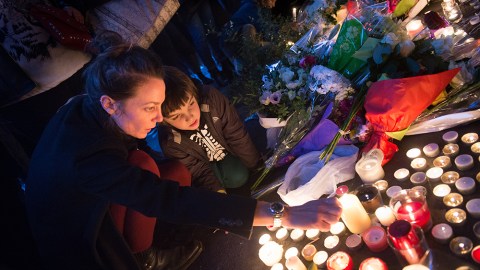Is Religion to Blame for Paris and Beirut?

Sufism has long been an important if small component of Islam. From the seductive teachings of Abu Yazid Bistami, an early Sufi who compared union with God to that of female sensuality, to the less extreme views of Al-Junayd of Baghdad, from the musings of El-Ghazali, Omar Khayyam, and Hakim Sanai to the jester Mula Nasruddin, no Sufi is as famous as Mevlana Jalal al-din Rumi, a poet of universal acclaim whose studentship to the mystic Shams of Tabriz is one of the greatest in history.
Rumi’s poem, the Masnawi, is considered scripture. Reverence for the prophet was not diminished while soul searching. It was actually enhanced, for Sufis had no wish to praise Muhammad with false idols. They would rather experience what he did, in their own way — something that some Muslims did not understand, and rebelled against, outright banning Sufism in various countries.
Yet Rumi’s legacy has been lasting. Born Jalalu’ddin Muhammed Ibn Muhammed in Central Asia in 1207 CE, Sufis immortalized him after death in 1273 with the Dance of the Whirling Dervishes. Adorned in a cloak (cubbe), long white robe (tennure), and cylindrical, conical-shaped hat (sikke), the dancers of the Mawlawiyyah Order twirl around an octagonal-shaped room (Semahane). Circulating around the Sheik (sufi leader), dervishes partake in a lengthy ceremony led by instruments such as the ney (reed pipe), kudum (small double kettledrum, played with a pair of sticks called zahme), rebab (fiddle-like stringed instrument), and, at times, the kanun (zither-like instrument with 72 strings) and tambur (lute-like instrument).
The traditional dance itself, such as on the ceremonial Nuptial Night (Sheb-I Arus) — held annually on December 17 to celebrate Rumi’s death — is defined by detail: the 14/4 Devr-I Kebir cycle; singing of a Naat (hymn without rhythm) composed by the classical Turkish artist Mustafa Itri; four Selas (salutation wishing peace and health); and an exacting form of spinning on the left foot with eyes closed or soft, gazing over their shoulder.
This precise attention to detail has symbolic significance. Dancing in such a manner leads the participant, as well as the spectators, into trance. A Sufi’s training is rigorous, be it the classical preparatory exercise of spinning with his first and second toes between a nail hammered into the ground or the recitation (dhikr) of divine names for hours on end.
What one is seeking during these rituals is dissolution, which may take hours. One’s body is not separate from one’s mind; both are irreversibly fused as one identity. A state of non-dualism emerges. The dancer gives up any sense of self, the heart of dervish practice. As noted Islamic scholar Idries Shah comments, “In ecstasy man is delighted; but when truth comes, it takes ecstasy’s place.”
While fana is the state a Sufi enters, he does not dwell there indefinitely. Baqa, revival, comes next. During the dance, every element plays a symbolic role. The dervish’s hat is a gravestone, his cloak a coffin, his white shirt a shroud. The main instrument, the ney, is the mythological Sur waking the dead on the day of Resurrection. In the hall, a line is drawn to divide the visible and invisible worlds, one end human, the other divine. Many elements comprise the ritual, but the most well-known is spinning, where the dervish flows counter-clockwise for an indefinite time as his cloak creates a circular parachute, the dancer engulfed by it while finding inner space within the cloth.
This twirling is the tribute to Rumi. Most importantly, each participant is recreating the original experience, much like various cultures reenact creation mythologies through rites of passage. Unlike religions that profess an imagined freedom after death, the Sufi is attempting to find liberation with this life. The circular dance is thought to reverse the flow of life.
For over 700 years since Rumi’s death, the Sufi ritual reminds devotees of their origins. The defining factor of Sufism is not only tolerance, but also complete acceptance of other religious practices as appropriate paths to the divine. We can argue what “divinity” entails or if it even exists, but what’s important here is that the key to Sufism is inclusion.
What happened last Friday in Paris, and a day before in Beirut, is the result of another Islamic offshoot in which there is only one appropriate path to the divine. Instead of symbols, this one involves a blood ritual. There can be no doubt that the believers of this sect are as devoted and certain of their path. Only their liberation is promised in the afterlife, making the carnage during this one possible.
My social media feed has been filled with numerous conflicting messages. Most of my colleagues and friends are expressing a blend of sadness, confusion, and, importantly, empathy. There is an understandable amount of fear. On occasion empathy is abandoned as an agenda is put forward: If only they were armed; American University students stop whining and take note; incredibly, Barack Obama is somehow to be blamed if that were to happen here.
And there’s the expectable crusade against any religion at all, though especially Islam right now. I am not of the mind that parts of Islam should not be criticized; religion plays an undeniable role in these tragedies. But to see talking heads spout off thoughtless crusades while the tragedy is still going on is heartbreaking and heartless. And then, of course, espousing the idea that it’s only that religion that’s the issue here, and [fill in religion or god] is the real solution.
Is religion the problem? Sometimes. Is religion the solution? Sometimes. The real problem, it seems, begins when you emphatically respond “yes” to either of these questions. There begins the path of “me” and the loss of “us.” The dance is over, and violence — physical, mental, emotional — commences.
Image: Thierry Orban / Getty





